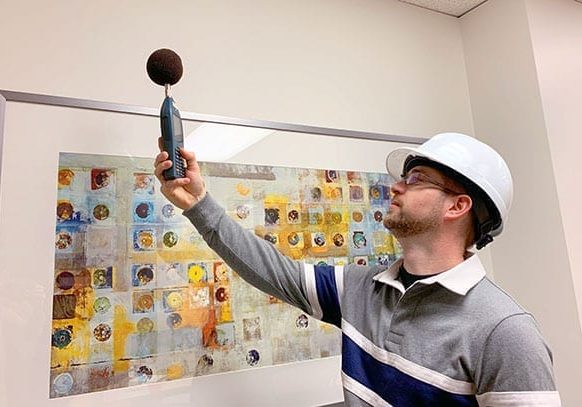HGC Engineering has been a valued support partner to leading developers, builders, architects, engineers, designers and planners in the development of major commercial and mixed-used projects across Canada, the US, the Caribbean, Europe and the Middle East.
Comprehensive Acoustical Engineering Solutions
We have worked on projects of all shapes and sizes including large multi-story, multi-tower developments, some of which are now considered to be landmarks in their communities, addressing a broad spectrum of noise, vibration and acoustical applications concerns. We have also partnered on teams developing corporate headquarters for globally recognized market leaders, contributing comprehensive acoustical solutions for for both core and shell buildings and office fit-outs.
Commercial, Retail & Residential Noise Know-how
While many of the mixed-use projects have included typical retail and residential additions (including food courts, theatres, healthcare and fitness centers) several have incorporated unusual and more acoustically challenging features like skating rinks, bus depots, broadcast studios, and financial trading floors.
Implicit in the design of successful office spaces from both a base-building and fit-out perspective is developing an acoustical environment that provides adequate speech comfort while offering freedom from sound distraction. We work with architects, designers and project managers to establish appropriate and effective benchmarks that attain desired acoustical performance goals.
The criteria that are targeted include A-weighted sound levels, Noise Criteria (NC), Room Criteria (RC), Reverberation Time, Noise Isolation, Speech Intelligibility, Masking Sound Levels, vibration perception, or vibration induced comfort limits. We will review the design layouts and drawings to provide recommendations for obtaining acceptable levels of speech privacy for open office spaces and good sound isolation for private offices, meeting rooms, multi-media centres and other gathering spaces, minimizing sound transmission between areas.
Ontario’s Tarion Builder Bulletin 19
Developers planning to incorporate a residential component to their project in the Province of Ontario must comply with the design and site review requirements of Tarion’s Builder Bulletin 19. Tarion is the regulator of Ontario’s new home building industry and is responsible for administering the Ontario New Home Warranties Plan Act. Builder Bulletin 19 sets out a process for the review of the design and construction of residential buildings to provide a reasonably thorough consideration of the potential for noise from occupants and building services equipment.
This process requires a certification of the final construction drawings to ensure they meet the acoustical design requirements. Once the final construction drawings have been completed a design approval certificate must signed by an acoustician and then forwarded to Tarion. In addition, shop drawings must be reviewed and site inspections and testing must be documented with reports forwarded to a project’s Field Review Consultant (FRC). HGC Engineering is well versed in the Tarion Builder Bulletin 19 Certification process.
Vibration Monitoring, Mitigation and Isolation
Our team also has extensive experience in assessing and mitigating the impact of ground-borne rail and subway vibration on a building and any sensitive equipment within. We have designed room-within-a-room configurations to isolate a corporate conference space from the effects of rail tunnel traffic. Our personnel has even gone so far as to isolate an entire building to shield its broadcast studios from the effects of subway ground-borne vibration. We also have the resources and capabilities to conduct vibration monitoring during construction, and use this extensive experience to help predict potential vibration impacts form construction or other activities.
LEED and WELL Certified buildings
We have also performed acoustical consulting for a variety of Green Building projects, which have become more prevalent in recent years. There are special challenges to developing good practices in acoustics for LEED and WELL Certified buildings, and we are familiar with the acoustical implications associated with their associated systems, standards and certification processes.
HGC Engineering offers consultation services relating to acoustics, noise and vibration at all stages of a project
During Planning
Environmental Noise and Vibration Studies
These feasibility studies examine the noise impact of nearby roads, highways, rail and subway traffic on the proposed site and its future occupants. As well, the study assesses the potential effects of vibration from adjacent subway or railway lines on a building’s foundation and structure. A study will also look at surrounding industries, buildings or activities nearby for potential stationary sources of noise or vibration that might impact the planned site. Additionally, we will review any early details the project team can provide on the site plans, looking for new noise and vibration sources associated with the design such as such as cooling towers, heating plants, loading bays, generators, helipads, that may in turn impact surrounding buildings and environments. These aspects are considered in a preliminary fashion in the context of a study and only general recommendations for mitigation of environmental noise and vibration are offered at this juncture.
At this Planning Stage we also offer:
- Expert Testimony for municipal hearings
- Peer Review
- Acoustic Design Spec and Brief for Design/Build RFP
During Building Design
We review the internal design of the building and its systems in order to provide acoustical guidance and recommendations to the architectural, mechanical, and electrical members of the team, with appropriate follow-up through construction.
- Preliminary Acoustical Design Review
Usually, it is beneficial to perform a preliminary review early in the design stage (at about 25% ready for construction), to ensure that provisions for unusual aspects are considered while there is still an opportunity to address them or to flag the issues for further analysis, ie stacking concerns, building orientation etc. As a result, alternative layouts or systems may be proposed for consideration. This will involve a review of the early architectural, mechanical, electrical drawings, as available. Many of our customers have come to recognize and value the benefits of our preliminary reviews and have now made them a standard part of their process in order to avoid costly changes and project delays that would otherwise have occurred later if not for our early input.
Establishing Acoustical Criteria: Based on our discussions with project team members, we will identify acoustical criteria (Noise Criteria (NC) or Room Criteria (NC) Levels, Reverberation Time, Noise Isolation, Speech Intelligibility, Masking Sound Levels etc.), for the various noise sensitive spaces such as classrooms, auditoria, library spaces, meeting spaces, private offices, etc. We will consider the spatial separations and acoustic privacy expectations, space stacking and general building services or general occupancy concerns. The criteria targeted will be based on meetings with team members, any information or measurement gathered and will address spaces within the building as well as suggested limits for impact on adjacent uses. A criteria report will be prepared and circulated outlining the recommended criteria and comments on the schematic design, for discussion purposes.
Façade and Glazing Specification: Once the drawings are sufficiently advanced, we provide refined glazing assembly requirements based on our previous environmental review and the latest floor layouts. This involves comparing the revised exposed glazing areas and associated room floor areas with those used in the environmental review and revising the glazing STC requirements, if appropriate, to meet indoor sound level criteria. - Detailed Acoustical Design Review
Once the working drawings are approximately 60% to 75% ready for construction, a full building design review can be provided. Our scope of work for such a review includes a thorough review of architectural, mechanical, and electrical drawings and specifications to identify areas where better details or modified assemblies may be warranted. Structural dynamics, for example, are sometimes identified as a potential source of vibration problem for sensitive equipment. (An Engineering department’s Scanning Electron Microscope can be adversely affected by the vibration caused by equipment in a adjacent mechanical room or the activities of a nearby Gymnasium or Basketball Court.) We will conduct acoustical analysis and treatment of sensitive spaces such as lecture halls, gymnasiums, atria etc. Where necessary, we will present mitigation recommendations on preferred noise and vibration control measures. This may include providing silencer recommendations for fan systems, cooling towers, generator sets, etc., vibration isolation recommendations of major or sensitive equipment to limit structure-borne noise, etc.
Mechanical and Electrical Systems: We will review the M&E drawings and the mechanical specifications to identify potential noise issues. Where improved details or upgraded noise control systems consistent with the goal for this building are warranted, comments or recommendations will be provided. Where a potential problem exists but more specific information about a particular mechanical or electrical system is required to perform a full assessment or to design mitigation, we will outline general requirements that can be added to the tender documents, placing onus for design on the supplier or installer.
Retail and Commercial spaces: Note that any planned retail and commercial spaces are reviewed as shell spaces, as the specific uses of such tenant spaces can change with a change in tenancy. The onus is usually placed on tenants to ensure that their activities are compatible with the building’s permanent space usages and provisions or precautions are incorporated in their fit-outs. However, in instances where specific tenant usage is indicated in the base-building design, our experience allow us to make sufficient assumptions on the nature of the types of equipment and activity which could be expected and offer mitigation suggestions accordingly (e.g., Coffee Shop, Healthcare suite, Fitness Club, Spa, etc.).
- Follow-up Review
Once the design team has indicted that they have integrated our recommendations into the construction documents (95-100% CD), a follow-up review can be conducted to confirm that our recommendations have been incorporated. Additional follow-up reviews required to address specific omissions or design changes may be required
During Construction
There are several aspects of the project during construction where we are also able to offer additional assistance for the design/build team.
Construction Vibration Assessment: Toronto is one of the few cities in North America with a City By-Law, 514-2008, that requires that a Construction Vibration Assessment be conducted in support of an application for a building or foundation permit. It mandates that a Professional Engineer assess the potential for impact on off-site structures in a “zone of influence” by the vibration effects of shoring, excavation and demolition activities. HGC Engineering is fully versed in all aspects of Construction Vibration Monitoring and Assessment. We offer the in-house know-how and monitoring technology your require to efficiently and cost-effectively meet your assessment and timeline requirements. Visit our Construction Vibration Monitoring and Assessment page for more details.
Shop Drawing Reviews: Shop drawings can be reviewed once the project enters the construction phase. We will review typical base-building equipment drawings for consistency with the specifications and recommendations contained in our initial review.
Site Inspections: Site inspections or field testing is often driven by the sensitivity of a specific issue, the complexity of its implementation or by the regulatory requirements as is the case in residential projects in Ontario (ie Tarion Bulletin 19). Comprehensive inspections focus on the correct implementation of he architectural details and mechanical noise and vibration controls and often include site discussions with the trades to ensure proper implementation. Testing may include verification of acoustic separations.
Post Construction
Commissioning: During commissioning we will conduct measurements of reverberation and background sound to confirm compliance with the criteria.
Noise and Vibration Complaints: We offer on-going noise and vibration complaint forensics and troubleshooting to building managers of both new and mature buildings.
Tenant Fit-Out: We can work directly with new post-construction tenants and their chosen interior design and build teams to address any acoustical related requirements within their space, including acoustical privacy and sound masking requirements.


Sun Life Financial Tower + Harbour Plaza Residences

The Eau Claire Tower, Calgary, Alberta

Tour Deloitte, Montréal, Québec

What to Know Before Calling an Acoustical Consultant to Deal with a Noise Problem

Mitigating HVAC Related Noise and Vibration Problems in Building Design

The Unforeseen Pitfalls of LEED Design from an Acoustical Perspective

Acoustical Challenges With Wood-Frame Double-Shear Panel Wall Construction
Who We Help
Our Markets
Engineers, Architects, Planners, Environmental Health & Safety Specialists, Developers, Owners/Operators and Property Managers in sectors including:
Need Answers?
Reach out to our acoustical consultants now.